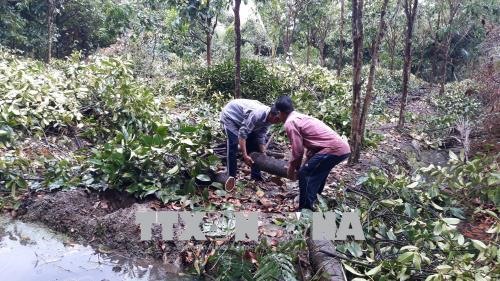 Society
Society

Many mangosteen farmers in Bến Tre Province have switched to other crops since yields have declined in recent years due to severe saltwater intrusion and local authorities are struggling to tackle the problem.
 |
| Farmers in Bến Tre Province are cutting down their mangosteen orchards and switching to other crops since saltwater intrusion has devastated yields. - VNA/VNS Photo Huỳnh Phúc Hậu |
HCM CITY — Many mangosteen farmers in Bến Tre Province have switched to other crops since yields have declined in recent years due to severe saltwater intrusion as local authorities struggled to tackle the problem.
Mangosteen is one of the key fruits of the Cửu Long (Mekong) Delta province, but its output has been falling since 2016.
Nguyễn Văn Thùy of Chợ Lách District’s Vĩnh Hòa Commune said he cut down his 3,000sqm mangosteen orchard two months ago to grow ochna.
Before 2016, his 20-year old orchard had 120 mangosteen trees and earned profits of VNĐ40 million (US$1,760) a year, he said.
After seawater began to flow upstream during dry months in 2016, he tried many methods to salvage his trees, but they stubbornly refused to fruit or fruited sparsely, he said.
Mangosteen trees can live up to 30-40 years and their yield increases with age.
In the province, the fruit is grown mostly in Chợ Lách, Châu Thành and Mỏ Cày Bắc districts.
But following the persistent saltwater intrusion, profits from mangosteen are unable to match those of other speciality fruits like green skin and pink flesh grapefruit and durian, and farmers are switching to growing and selling seedlings.
In Chợ Lách, the province’s largest mangosteen planting district, the area under the fruit had shrunk from 1,127ha in 2014 to 969ha last year.
Lê Văn Sơn, who owns a 1.1ha orchard in Phú Sơn Commune, said in the past an old mangosteen tree could produce 300-400 kilos of fruits a year.
“This year my mangosteen trees have few fruits.”
His yields begun dropping in 2014-15, and after the saltwater intrusion became severe in 2016, many of his trees stopped fruiting altogether.
Since then he has gradually cut down around 6,000sq.m of trees and replaced them with mango and durian nurseries to sell saplings.
His new business can fetch profits of VNĐ150 million ($6,600) every two years per 1,000sq.m while mangosteen only provides VNĐ6-20 million ($260 - 880) a year, he said.
Many farmers in Chợ Lách’s Vĩnh Hòa Commune have cut down part of their mangosteen orchards to grow other trees, but retained a part of their mangosteen trees in the hope things will turn around and they will again bring high profits.
Trần Minh Đức, chairman of the Vĩnh Hòa Commune People’s Committee, said the local mangosteen is famous for its delicious taste, and many farmers have become wealthy by growing the fruit.
Before 2015, the commune produced about 4,000 tonnes of mangosteen a year, but the saltwater intrusion has reduced that by 50 per cent, Đức said.
Many mangosteen orchards in Chợ Lách’s Phú Phụng, Vĩnh Bình, Sơn Định, and Hòa Nghĩa communes have also been affected by the gamboge disorder, which causes yellow exudation of gum on to the fruits’ surface.
The province’s agriculture officials have not had been able to resolve the issues of fruiting and gamboge disorder.
Bùi Thanh Liêm, head of the Chợ Lách Agriculture and Rural Development Bureau, said the tree is sensitive to weather changes and saltwater.
When there is saltwater intrusion, it may not flower or even die, he said.
Mangosteen can only grow well in areas where there is no saltwater and the weather is favourable, he said.
It would be difficult to maintain and expand the mangosteen growing area in future, he admitted.
The area under the fruit in the province fell from 1,627ha in 2015 to 1,016ha in 2016, according to its Sub-department of Plant Cultivation and Protection.
Võ Văn Nam, head of the sub-department, said there is no official data on the current mangosteen growing area, but it is definitely reducing gradually. — VNS




